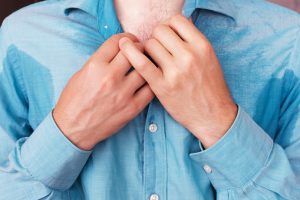
Hyperhidrosis is an excessive sweating condition that is not necessarily related to higher temperatures or exercise. It often goes underdiagnosed, according to Dr. Robert Korst, medical director of the Valley Health System’s hyperhidrosis center in Ridgewood, N.J., as most people affected don’t even realize their abnormal sweating is a medically treatable condition.
People normally sweat when their body senses that the surrounding temperature around them is too warm, and to cool the body, the skin releases sweat. Once evaporated, it dissipates excessive heat from the body. Other situations where sweating might occur normally are during exercise, when nervous, anxious, or under stress. Those with hyperhidrosis far exceed these normal conditions, sweating profusely at any time, to the point that the mere thought of shaking hands with someone can start a sweating response. Sweating can be generalized or localized to specific parts of the body such as the hands, feet, armpits, or even the groin.
Typically, hyperhidrosis begins during childhood, with genetics and family history possibly playing a role in its development. However, it is generally considered to have an unknown origin. Three main types of the disorder are recognized, having distinct treatment modalities.
Primary focal hyperhidrosis: Problematic sweating that occurs in specific parts of the body, such as the hands, feet, underarms, and face. Sweating is so excessive that it drips off the skin, being very noticeable, which may lead to symptoms of anxiety and depression. Cases of skin irritations and infections can occur as well.
Generalized idiopathic hyperhidrosis: Results in excessive sweating on a large area of the body.
Secondary generalized hyperhidrosis: This subtype is thought to be secondary to another medical condition, such as menopause, thyroid disorder, or diabetes. A variety of cancers and endocrine disorders have been associated with secondary generalized hyperhidrosis. The use of certain medications like selective serotonin reuptake inhibitors (SSRIs) can also be a contributing factor.
The goal for the treatment of hyperhidrosis is to control symptoms. Your particular treatment option will depend on the severity, with some people needing a combination of therapies. The following are some examples of frequently used treatments:
Medications
- Prescription antiperspirant
- Nerve-blocking medications
- Antidepressants
- Botulinum toxin injections
Surgical
- Electrical current (iontophoresis)
- Sweat gland removal
- Nerve surgery
Having hyperhidrosis can be very distressing and can actually lead to further psychological issues. If you suspect you may have this condition, it is advised to speak to you doctor about treatment options.
Related: Itchy armpits (itchy underarms) causes, symptoms, treatments, and home remedies